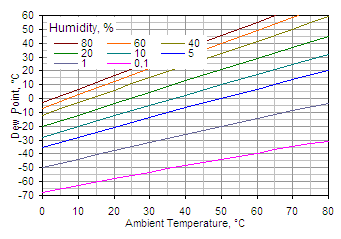Application Tips
Thermoelectric cooler (TEC) is a semiconductor device which is characterized by unique heat pump performance with high efficiency, compactness and durability. The unique ability of TECs to heat and cool, permits them to lower temperature of an object below ambient as well as to stabilize temperature of objects in widely varying ambient conditions.
Here we mention some application tips that can help in optimal use of TECs.
Mounting
Power Supply
Environment
Handling
Heat Dissipation
Reference Data
Brief Summary
DEW POINT OPERATION
TEC in many cases provides cooling below below ambient. The target temperature often is below dew point of regular ambient.
Moving down below dew point leads to water condensation from moist ambient. The water condensation is a reason of short circuit in TEC and degradation of thermoelectric material.
If TECs must work in regular ambient, to prevent the problem it is necessary to protect TECs against moisture. TECs with special protections are supplied by customer demands. RMT has patented method of such protection.
In a case of miniature single and multistage TECs which are usually placed into evacuated volume it is necessary that filling gas should have dew point below target cold temperature.
-

-
Well-known approximation used to calculate the dew point Td gives the relative humidity RH and the actual temperature T of air as:


where the temperatures are given in degrees Celsius and «ln» refers to the natural logarithm. The constants are: a = 17.27, b = 237.7 °C.
To prevent water condensation filling gas must be dry and have dew point lower than cooling temperature.
Examples
In the table there are advised some typical cooling temperatures provided by different types (stages) TECs. For such typical applications filling gas must have dew point exactly below the temperatures.
| Type of TEC | Typical target cooling, °C | Gas RH*, not more % |
|---|---|---|
| Single stage | -20 | <1 |
| Two-stage | -30 | <0.5 |
| Three-stage | -50 | <0.05 |
| Four-stage | -70 | <0.005 |
* - at room temperature
For multistage TEC cooling dry gas ambient is required or vacuum arrangement is preferable.


